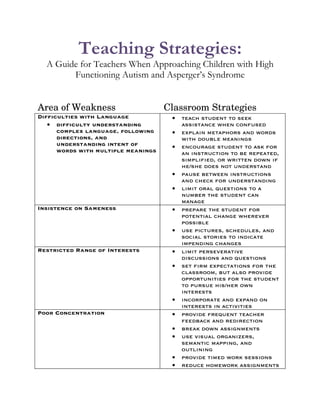
Teaching Strategies: A Guide for Teachers When Approaching Children with High Functioning Autism and Asperger’s Syndrome
- 1. Teaching Strategies: A Guide for Teachers When Approaching Children with High Functioning Autism and Asperger’s Syndrome Area of Weakness Classroom Strategies Difficulties with Language • teach student to seek • difficulty understanding assistance when confused complex language, following • explain metaphors and words directions, and with double meanings understanding intent of • encourage student to ask for words with multiple meanings an instruction to be repeated, simplified, or written down if he/she does not understand • pause between instructions and check for understanding • limit oral questions to a number the student can manage Insistence on Sameness • prepare the student for potential change wherever possible • use pictures, schedules, and social stories to indicate impending changes Restricted Range of Interests • limit perseverative discussions and questions • set firm expectations for the classroom, but also provide opportunities for the student to pursue his/her own interests • incorporate and expand on interests in activities Poor Concentration • provide frequent teacher feedback and redirection • break down assignments • use visual organizers, semantic mapping, and outlining • provide timed work sessions • reduce homework assignments
- 2. • seat at the front of the classroom • use non-verbal cues to get attention Poor Organizational Skills • use personal calendars and organizers • maintain list of assignments • help student use “to do” lists and checklists • place pictures on containers and locker • use picture cues in locker Academic Difficulties • do not assume that the child • usually average to above- has understood simply because average intelligence he or she can re-state the • good recall of factual information information • be as concrete as possible in • areas of difficulty include presenting new concepts and problem solving, abstract materials comprehension, and abstract • use activity-based learning concepts where possible • may do well at math facts, • use graphic organizers such but not problem solving as semantic maps and webs • break tasks down into smaller steps or present it in another way • provide direct instruction as well as modeling • show examples of what is required • use outlines to help child take notes and organize and categorize information • avoid verbal overload • capitalize on strengths • do not assume that the child has understood what he or she has read—check for comprehension, supplement instruction, and use visual supports Additional Suggestions • introduce unfamiliar items in a familiar environment when possible • organize teaching materials and situation to highlight what is important
- 3. o help the student attend to pertinent information o Example: present only the text you want to read, not the whole book • know the individual and maintain a list of strengths and weaknesses • Note aspects of tasks and activities that create frustration • Provide relaxation opportunities and areas • carefully word praise so it is behavior-specific • provide reinforcers that produce the desired student response • use age-appropriate materials • provide opportunities for choice • (Adapted from: Teaching Students with Autism: A Resource Guide for Schools. British Columbia Ministry of Education: Special Programs Branch. 2000.) A student with Asperger’s testimony on teaching approaches: “There were classes with an accelerated pace that I thrived in (Biology Honors, for one), but there were classes where I felt that my teachers really needed to slow down and stop cramming the information down the throats of their students (there is a former Clemson professor here at WCU, whom I won't name, that taught my Calculus II class and she had the pace of an ACC basketball game through some of the most crucial parts of the class, and glossed over things that probably would have helped us out). There were some things certain teachers did do that were especially helpful, specifically Mrs. Kuether at PCHS, who interspersed stories with instructional material, which helped me figure out what was important and not so important. Also, Mrs. High, who used to teach at Fairview Elementary, did the same thing. And my advisor here at Western Carolina University, Dr. Shan Manickam, also intersperses stories in between instructional times. I truly appreciate that, as I can figure out where to draw the line between what is important and not important, because when some profs just stand up there on that lectern and drone on
- 4. for hours, the line between what is and isn't important gets very blurry and makes it VERY difficult to study for tests in those classes.” BJ, 23 years old
